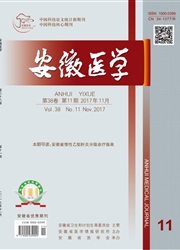

 中文摘要:
中文摘要:
目的 了解2009至2011年安徽地区粪肠球菌与屎肠球菌的临床分布及耐药情况,为临床合理用药提供参考证据.方法 185株粪肠球菌与屎肠球菌药敏试验采用琼脂稀释法,结果依据CLSI 2010年推荐的标准进行判读.结果 3年临床分离菌株共185株,其中粪肠球菌92株,屎肠球菌93株,主要分离于尿液及分泌物,其中粪肠球菌分别占63.4%和11.8%,屎肠球菌分别占48.9%和16.3%;粪肠球菌对青霉素、氨苄西林、环丙沙星、左氧氟沙星和加替沙星的敏感性高于屎肠球菌,屎肠球菌对万古霉素、替考拉宁和利奈唑胺的敏感性高均达90%以上,粪肠球菌对三者的敏感性均在90%左右,然而无论粪肠球菌和屎肠球菌对红霉素的耐药性均很高,分别为76.3%和92.6%.结论 粪肠球菌与屎肠球菌对不同的抗菌药物的敏感性不同,临床上应加强对粪肠球菌和屎肠球菌的监测及抗菌药物使用的管理,预防和减少耐药菌株的产生.
 英文摘要:
英文摘要:
Enterococcus faecalis (E. faecalis) and Enterococcus faeeium ( E. faecium) in order to provide reference for clinical rational use of antibiotics. Methods The antimicrobial suscepti- bility test to 185 strains of E. faecalis and E. faecium was performed by agar dilution method. The results were judged according to the criteria recommended by Clinical and Laboratory Standards Institute (CLSI) 2010. Results There were a total of 185 clinical isolates in three years~irtcluding 92 E, faecalis, 93 E. faecium, which were mainly isolated from tldne and secretions, including E. faecalis, 63.4% and 11.8%, E. faecium 48.9% and 16.3 %, respectively. Penicillin, ampicillin, elprofloxacin, levofloxacin and gatifloxacin as antimicrobial a- gents ~ E. faecalis were more sensitive than E. faecium. E. faeeium had a high sensitivity to vancomycin, teicoplanin and linezolid over 90% , E. faeealls was about 90%. But both E. faecalis and E. faecium were resistant to erythromycin high, respectively,76.3% and 92.6%. Conclu- slorl E, faecalis and E. faecium have different sensitivity in different antimicrobial drugs, and the surveillance of antimicrobial resistance and management of the use of antibiotics in E. faecalis and E. faecium should be strengthened to prevent and reduce drug - resistant strains.
 同期刊论文项目
同期刊论文项目
 同项目期刊论文
同项目期刊论文
 Prevalence of plasmid-mediated quinolone resistance determinants in association withb-lactamases, 16
Prevalence of plasmid-mediated quinolone resistance determinants in association withb-lactamases, 16 Stenotrophomonas maltophilia resistance to trimethoprim/ sulfamethoxazole mediated by acquisition of
Stenotrophomonas maltophilia resistance to trimethoprim/ sulfamethoxazole mediated by acquisition of Detection of the plasmid-mediated quinolone resistance determinants and the emergence of multidrug r
Detection of the plasmid-mediated quinolone resistance determinants and the emergence of multidrug r Surveillance of Antimicrobial Susceptibility Patterns among Shigella 5 Species Isolated in China dur
Surveillance of Antimicrobial Susceptibility Patterns among Shigella 5 Species Isolated in China dur 期刊信息
期刊信息
